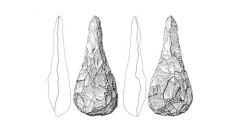

 Comptes Rendus Palevol
17 (1-2) - Pages 45-60
Comptes Rendus Palevol
17 (1-2) - Pages 45-60Assemblages with bifacial tools cover large areas of the Eurasian continent from the Middle Pleistocene to the Upper Pleistocene. These encompass varied technological strategies although the morphological results are often similar. Consequently, bifacial technology is diversified in Eurasia and cannot be correlated to “Acheulean-type behaviour” everywhere, or for all time periods. While early lithic assemblages with bifacial technology appeared in Africa as early as 1.8 Ma, this technology is observed in Eurasia from 1.5 Ma for the earliest evidence, and particularly from 1 Ma onwards. Our purpose here is to focus on Eurasian patterns. This presentation will be divided into three parts in order to describe, clarify and compare the bifacial phenomenon regarding its chronological and geographical extension, based on examples of key sites in diverse Eurasian areas. This first paper presents a review of detailed data from western and southern Europe and the Levant. The second focuses on the East, India, south-eastern Asia and eastern Asia (China). The third and final paper is a comparative analysis of Eurasian areas with occurrences of bifacial technology in relation to paleoanthropological remains in order to clarify the diversity of the bifacial technological phenomenon over time and space. Major European and Levantine sites are described in this first paper. For Europe, the bifacial component is divided into two main currents; before and after the major glacial event of MIS 12. Before MIS 12, sites such as la Noira, Notarchirico, Caune de l’Arago, Galeria II, Cagny-la-Garenne I-II or Boxgrove are taken into consideration. After MIS 12, sites are more numerous and have been widely reviewed (for instance Terra Amata, Guado San Nicolas, Cagny l’Epinette, Soucy…). For the Levant, sites such as Ubeidiya, GBY, Nadaouiyeh and El Meirah are presented. Data from the Arabian Peninsula are also taken into account.
Bifacial tools, Europe, Levant, Technology